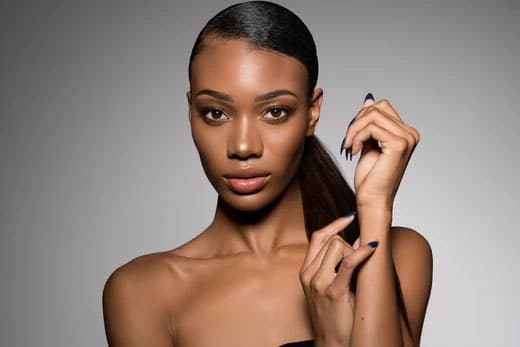Permanent makeup has been trendy for quite a while now. And why not? Waking up with an already made-up face saves a lot of time and effort to get ready!
Permanent makeup or tattooed makeup has evolved a lot since its first emergence in the 1980s. It no longer looks like a shabby line of tattoos around the facial features. Now, with the top-notch professionalism of skilled permanent makeup artists, permanent makeup looks natural and seamless.
However, permanent makeup has always been a tricky affair for women of color. The melanocytes present in our skin cells give our skin its characteristic color. Along with that, melanin-rich skin has its own complications when it comes to permanent makeup. It is obvious that colors do not show up as much on women of color or can look totally different to the desired outcome. It takes an experienced and trained permanent makeup artist to make the colors pop and last longer on darker skin. Given that most permanent cosmetic procedures cannot be reversed, it is crucial to find a certified technician who will take the necessary steps to perform permanent makeup procedures on women of color.
How to Choose The Right Pigment For Your Skin
If you are a woman of color, you are probably confused about the undertone for your skin necessary for picking out the right pigments for your microblading procedure.
The best way to find out is by checking out the Fitzpatrick scale. It is a beneficial tool for permanent makeup artists, especially microblading artists, who work on eyebrows and lips.
This scale is purely based on the amount of melanin pigment present in the basal layer of the skin’s epidermis. Since melanin can be black, brown, or blue, the same pigment can look different on different skin tones. You can simply take the Fitzpatrick Skin Type Scale Test, the results of which depend on factors such as genetics, reaction to UV exposure, and tanning habits. This will help your permanent makeup artist choose the right pigment for your skin that will impart a natural look and heal quicker and last longer.
Importance of Skin Tone Analysis
A natural look that blends in with your skin is all you want when going for a permanent makeup session. This sounds easy but is actually challenging to execute on women of color. This is because women of color have a higher percentage of melanin and oil glands as compared to white skin.
As a result, after a permanent makeup procedure, the healing skin will either show hyperpigmentation (excess production of melanin causing darker areas) or hypopigmentation (lack of melanin production causing lighter areas).
For instance, if light pink pigments are used on the lips on African-American skin, it tends to become an unattractive purple color with time. Likewise, in Indian skin, darker shades on eyebrows can turn lighter with time, thus, defeating the purpose of doing it in the first place.
Analysis of the skin type and undertone is a crucial step that needs to be undertaken before performing permanent makeup procedures. This is because skin pigments are certainly not “one size fits all.†Every skin type is different and will take up pigments in different manners. Microbladed eyebrows can give off a bluish tint on skin with cool undertones if done incorrectly. It may end up looking pink or orange if the skin has warm undertones. Understanding color theory to pick out the right shades for performing permanent makeup procedures can make a significant difference in results.
Does Needle Depth Play an Important Role?
The depth of the needle may determine the amount of pigment that is being transferred onto the skin.
If the needle is too far out, it can impede ink flow and not give a saturated color payoff.
On the flip side, if the needle is projected too low, it can cause pigment overflow all over the client’s skin.
In both cases, how far the needle must go into the skin depends on how thick the client’s skin is. When the needle goes to a shallow depth, the pigment will only reach the upper epidermis, and as a result, the procedure will not be long-lasting. On the other hand, if the needle goes too deep, the skin will take way longer to heal and cause scarring and an undesirable ashy color payoff.
Oily Skin and Permanent Makeup
Oily skin has more sebaceous glands and oil glands as compared to any other skin type and women of color tend to be of the oily skin type. Since the skin constantly produces oil that is being released from the pores regularly, microblading and permanent makeup tend to have really less longevity and fades out faster. This is because the pigments get diluted by the oil and cause a blurred-out look.
If you have oily skin, you have to go for frequent touch-ups to keep the permanent makeup looking fresh. Even though microblading is not recommended for very oily skin types, a better option would be an ‘ombre brow’ or ‘shaded brow.’
Another thing to note, many experts mix Vitamin C in pigments to brighten the color to prevent the pigment from going blurry or ashy.
Final Thoughts
Permanent makeup is a widely popular beauty procedure and is versatile enough to be carried out on all skin tones and types. However, intradermal pigmentation stands as a barrier between permanent makeup and women of color. It is often a risky venture to be undertaken by many permanent makeup artists, microblading artists, and estheticians.
It is advisable to always undergo a patch test before undergoing such permanent procedures that can seldom be reversed.
With the right knowledge about colors, skin undertones, and techniques, you can surely achieve the desired results. We hope that with this article, we could give you a comprehensive guide about permanent makeup for women of color.


